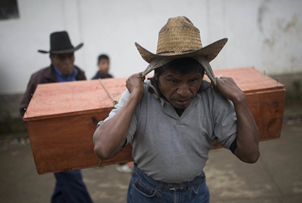
Even as post-earthquake rebuilding continued, yet more suffering descended on Guatemala.
Now “La Violencia” ruptured society. Increasing government military-led efforts to forcefully eliminate guerilla threats resulted in increased oppression throughout much of Guatemala, especially in the Highlands.
By the end of the violence, nearly 200,000 people had been killed, 83 percent of whom were Maya. The commission for Historical Clarification (CEH, 1999) attributed 93 percent of the murders and disappearances to the national army or paramilitary forces and 3 percent to the leftist guerrillas. Chimaltenango was one of the departments most affected by the violence, due in part to the high proportion of Maya residents, geographical location, and the “rural awakening” in which rural communities had begun to question sociopolitical inequalities. (Maupin. Shifting Identities)
The Behrhorst program was directly affected by this dark time in Guatemala. Gunmen killed Dr. Soza, a member of the Behrhorst Clinic staff. Chepe Pajarito, the director of the land loan program, ULEU, was “disappeared.” Eleven of the 47 promoters active prior to the violence were killed as were eight others in the expanded program in distant Uspantán, Quiché. The Behrhorst village-based health work was left in shambles when people needed the services so desperately.
During the violence the door of the Clinic and Hospital remained open, though activity was severely reduced. Travel from villages into the town of Chimaltenango ground to a halt. Nightfall curfews were enforced. Rumors were rampant and fear prevailed. Yet, Doc and local staff committed themselves to offering services, despite the personal risk.




